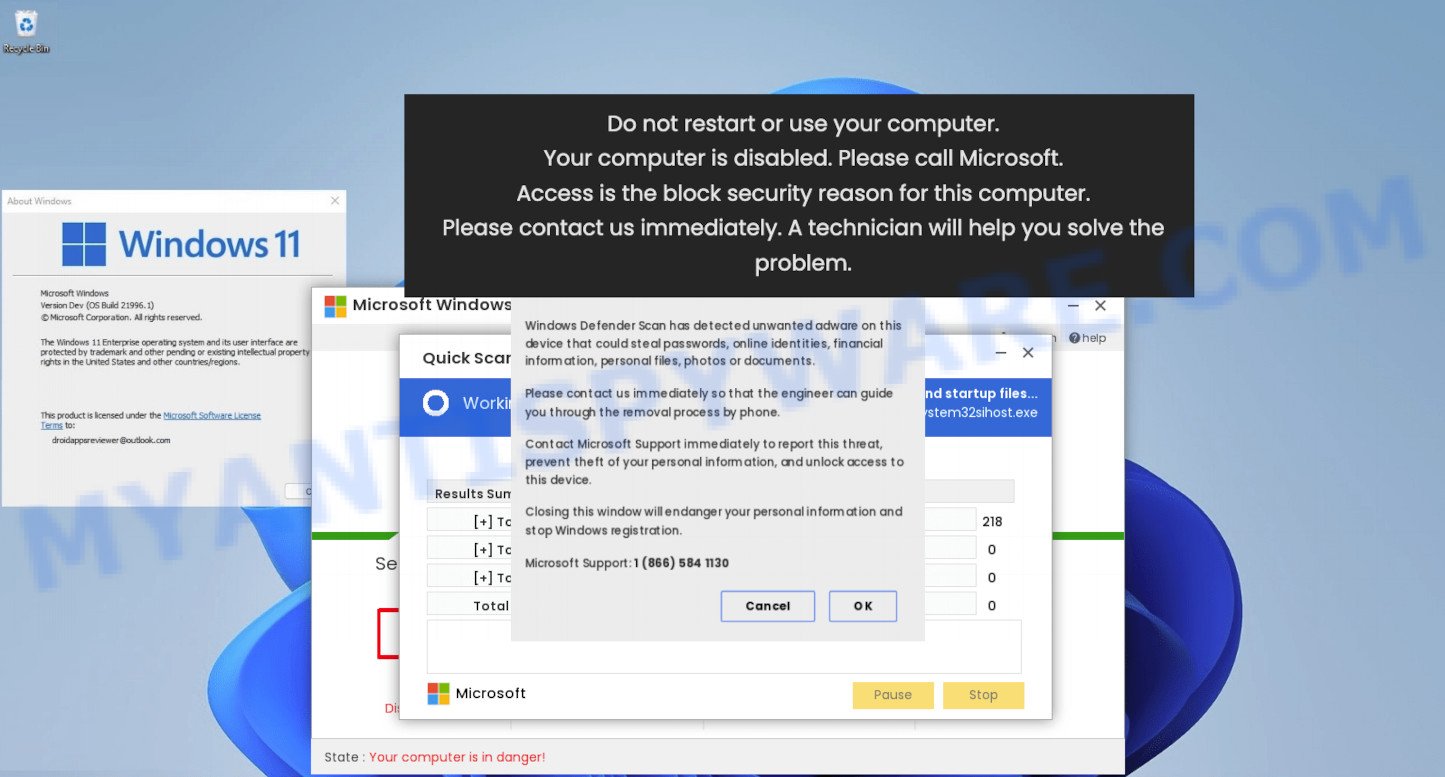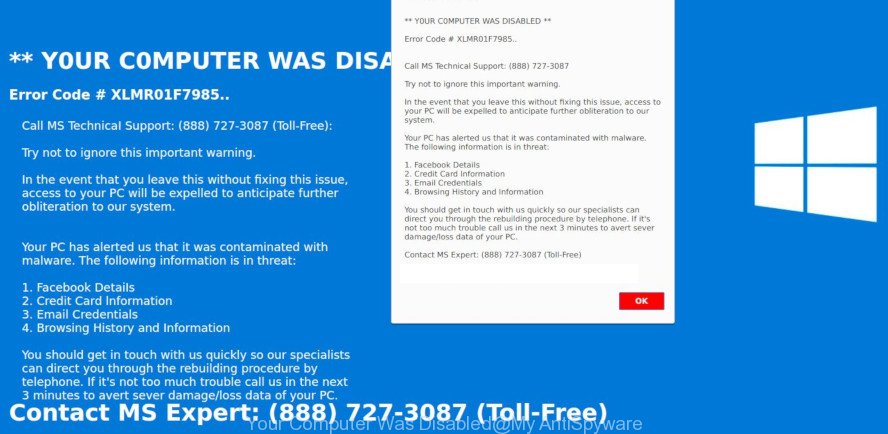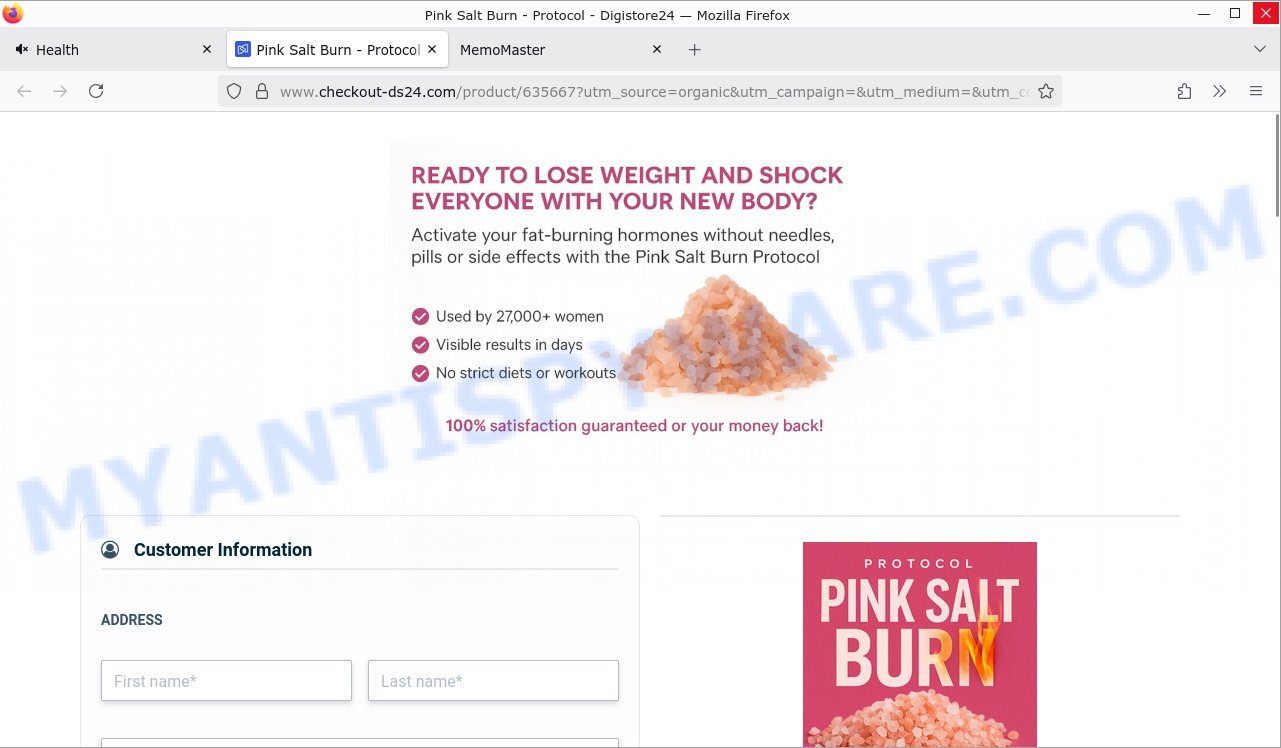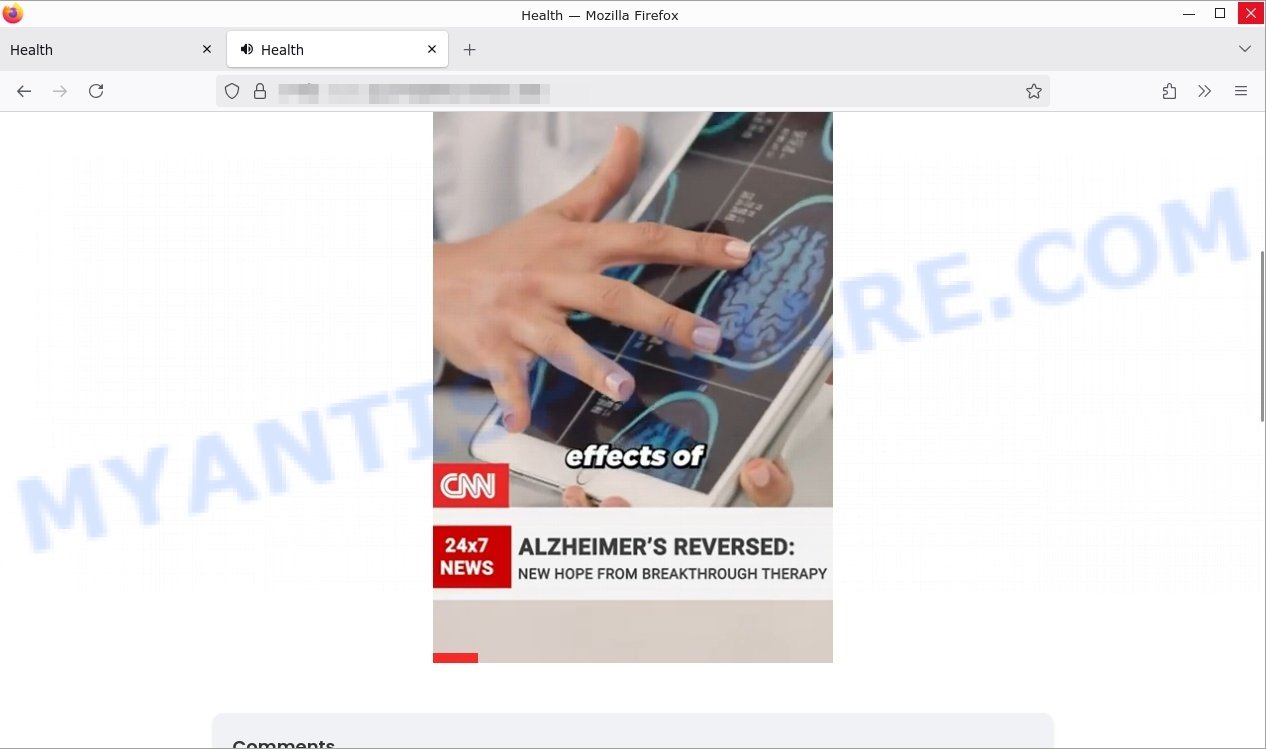Beware of the “Windows Defender Security Has Disabled Your Computer” pop-up scam—a sneaky fraud designed to scare you into giving away personal information or paying for fake tech support. This pop-up abruptly appears while you’re browsing, mimicking legitimate Windows alerts with official-looking logos and urgent warnings claiming your computer is locked or compromised. It instructs you to call a toll-free number like 844-590-4939 for immediate help.
- “Your computer is disabled. Please call Microsoft.” is a SCAM
- “Your Computer Was Disabled” pop-up
These scammers prey on fear and confusion, insisting that your device is at risk and only they can fix it. But in reality, there’s no security breach; this is a classic scare tactic to trick you into sharing sensitive data, granting remote access, or buying unnecessary services. Legitimate companies like Microsoft do not display unsolicited pop-ups demanding you call a number or pay fees.
If you encounter such a message, don’t panic or engage with the scammers. Close the browser window or restart your computer if needed. Never call the number or provide any personal information. Instead, rely on trusted security software and official support channels to protect your computer. Always remember: real tech support won’t use scare tactics or unexpected pop-ups to solve problems. Stay alert and don’t let fraudulent alerts take control of your device!
💡 Heads-up: Similar Scams Are Everywhere. Windows Defender Security Has Disabled Your Computer is not unique. It is one of many fake supplements, gadgets, and other schemes we expose in our Fact Checks section. All of them aim to grab your personal data or money. The people behind these scams run slick websites, spread bogus promo codes, and even pose as trusted brands or experts. Below are a few recent scams that follow the same playbook as Windows Defender Security Has Disabled Your Computer: MemoMaster, RetroSnap Play, HZA Dentures, Buffalo Trace 250th Anniversary Advent Calendar, AquaSculpt.
Table of Contents
🚨 Is the “Windows Defender Security Has Disabled Your Computer” Pop-Up a Scam?
The alarming pop-up claiming “Windows Defender Security Has Disabled Your Computer” is a classic tech support scam designed to frighten users into calling fake Microsoft support numbers. These deceptive tactics prey on users’ fears, making them believe their computer has been compromised or locked by Windows Defender, pushing them to seek immediate help from scammers.
Key Red Flags:
- 🌐 Fake Pop-Up Alerts: The warning appears suddenly while browsing and mimics official Microsoft branding, but it is not generated by Windows Defender or any legitimate Microsoft software.
- ⭐ Scare Tactics with Urgent Messages: The pop-up uses alarming language such as “Windows Defender security has disabled your computer”, urging users to act immediately by calling a provided phone number.
- 🔒 Fraudulent Phone Numbers: The included number (e.g., 844-590-4939) directs victims to scammers pretending to be Microsoft support agents, who may attempt to steal money or gain remote access to your computer.
- ⚠️ No Real Technical Issues: The alleged problem does not exist; your computer is not disabled or infected. Legitimate notifications from Microsoft never include direct phone numbers or demand urgent calls.
- 📉 Poorly Designed and Persistent Pop-Ups: The warning refuses to close or redirects you to scam websites when you try, attempting to trap users in the fake security alert.
- 👤 Unsolicited Contact Details: Legitimate tech companies do not randomly provide phone numbers in pop-ups to unsolicited users. Official support requires contacting through verified channels.
- 🔗 Attempts to Extract Payment or Personal Information: If you call, scammers might request payment for fake “repairs”, personal data, or install malware under guise of fixing issues.
In summary, the “Windows Defender Security Has Disabled Your Computer” pop-up is a scam designed to deceive and intimidate users. It uses fake warnings, fabricated phone numbers, and aggressive tactics to trick victims into contacting cybercriminals. Do not call the number or provide any personal information. Instead, close your browser, run a legitimate antivirus scan, and consult with authorized Microsoft support channels if you have concerns.
🕵️♂️ How the “Windows Defender Security Has Disabled Your Computer” Scam Operates
The “Windows Defender Security Has Disabled Your Computer” pop-up scam is a deceptive tactic used by cybercriminals to trick users into paying for fake tech support. 🚨 It’s a type of fraud where fake security alerts are shown on your screen, falsely claiming your computer is disabled or infected, aiming to scare you into calling bogus support numbers and handing over money or personal information.
🔗 Step-by-Step Breakdown of the Scam:
🛑 Fake Security Pop-Up Appears
While browsing the web, often on dubious or compromised websites, a full-screen pop-up suddenly takes over your screen. It looks very official, mimicking Microsoft’s branding and uses alarming messages like:
“Windows Defender Security has disabled your computer. Please contact Microsoft at 844-590-4939 to unlock your computer.”
This pop-up is designed to cause panic and urgency, making users believe their system is compromised or locked.
📞 Pushing Victims to Call Scam Support
The pop-up prominently displays a toll-free number. Victims are instructed to immediately call this number to fix the so-called “critical security issue” on their computer. The scammers posing as “Microsoft technicians” answer the calls.
💻 Gaining Remote Access
Once the victim calls, the scammers often instruct them to install remote access software, allowing the fraudsters to take control of the victim’s computer. They might pretend to scan the system and “discover” serious problems that don’t actually exist.
💵 Charging for Fake Services
The scammers pressure victims into paying for unnecessary “repairs”, “antivirus software”, or “security subscriptions” — often demanding hundreds of dollars via credit card, wire transfer, or gift cards.
🔒 Leaving Your System Vulnerable
Instead of fixing any real issues, scammers may install malware, steal personal files or credentials, or simply leave your computer protected only by what you originally had, all while having remote access to cause further harm.
🚫 Refusing Refunds and Disappearing
After payment, scammers cut off contact or disappear entirely. Victims often find no way to get refunds or assistances, and their systems may remain at risk or compromised.
⚠️ Using Intimidation Tactics
The pop-up and scammers’ verbal tactics rely heavily on fear and urgency, trying to rush victims into decisions without time to verify the legitimacy of the alert.
In summary, the “Windows Defender Security Has Disabled Your Computer” scam deceives users by showing fake critical security alerts designed to trigger panic and force them into calling fraudulent support numbers. The scammers exploit this trust to gain remote access, steal money, and compromise personal data. Always remember, Microsoft does not display warning pop-ups asking you to call specific phone numbers. If you see such a message, close your browser, run a trusted antivirus program, and never call the number or provide payment information.
😱 What to Do If Scammed
If you find yourself ensnared by the Windows Defender Security Has Disabled Your Computer Scam, immediate action is crucial. Here’s what you should consider doing:
🛑 Stop Further Transactions
The first step is to halt any additional transactions that might be in process. Contact your bank or credit card provider and inform them that you’ve fallen victim to a scam. They can help by blocking the card or reversing any unauthorized transactions.
📞 Report the Fraud
File a report with your local police and provide all the available evidence, such as screenshots, emails, and website URLs. Additionally, report the scam to online portals like the Better Business Bureau (BBB) at www.bbb.org or the Federal Trade Commission (FTC) at reportfraud.ftc.gov. If you’re in another country, reach out to your national consumer protection agency.
💻 Take Screenshots
Before the scam website gets taken down or changes, make sure to capture screenshots of your transactions and communications. These can serve as evidence if you decide to pursue legal action.
⚖️ Consult Legal Advice
Speak to a legal advisor about your situation. While pursuing legal action may be time-consuming and costly, it could be a possible avenue for recovering your lost money.
📢 Share Your Experience
Use social media platforms to share your experience and warn others about the scam. Your story could prevent someone else from falling victim to the same or similar scams.
Conclusion
The “Windows Defender Security Has Disabled Your Computer” pop-up is a dangerous scam designed to frighten and manipulate users into calling fake support numbers. This scam uses official-looking Microsoft logos and urgent, alarming messages to create a false sense of legitimacy and emergency, tricking you into disclosing personal information or paying for unnecessary services.
Instead of protecting your computer, these fraudulent pop-ups aim to steal your money or install malware. Genuine Windows Defender and Microsoft security alerts would never lock your computer or demand you call a phone number to unlock it. The scammers exploit fear and urgency to pressure you into immediate action without time to think or verify legitimacy.
Bottom Line: Never call the numbers displayed in unsolicited pop-ups claiming your Windows Defender has disabled your computer. Close the pop-up using Task Manager or by restarting your device, scan for malware with trusted antivirus software, and seek help only from official Microsoft support channels. Stay vigilant and remember: legitimate security alerts will never use scare tactics or demand payment over the phone. If something seems suspicious, it most likely is a scam.






















